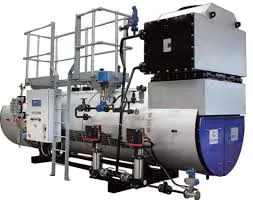Jun . 21, 2024 16:40
Back to list
Benefits of installing a waste heat recovery system for fuel-fired furnaces
Benefits of installing a waste heat recovery system for fuel-fired furnacesA large amount of the heat supplied by most fuel-fired heating equipment is wasted as exhaust or flue gases. In furnaces, air and fuel are mixed and burned to generate heat, some of which is transferred to the heating device and its load. When the heat transfer reaches its practical limit, the spent combustion gases are removed from the furnace via a flue or stack. At this point, these gases still hold considerable thermal energy. In many systems, this is the greatest single heat loss. The energy efficiency can often be increased by using waste heat gas recovery systems to capture and use some of the energy in the flue gas.
Heat Recovery 101: Exhaust gas loss or waste heat depends on flue gas temperature and its mass flow, or in practical terms, excess air resulting from combustion air supply and air leakage into the furnace. The excess air can be estimated by measuring oxygen percentage in the flue gases. Waste Heat Recovery Heat losses must be minimized before waste heat recovery is investigated. The most commonly used waste heat recovery methods are preheating combustion air, steam generation and water heating, and load preheating. Preheating Combustion Air A recuperator is the most widely used heat recovery device. It is a gas-to-gas heat exchanger placed on the stack of the furnace that preheats incoming air with exhaust gas. Designs rely on tubes or plates to transfer heat from the exhaust gas to the combustion air and keep the streams from mixing Another way to preheat combustion air is with a regenerator, which is an insulated container filled with metal or ceramic shapes that can absorb and store significant thermal energy. It acts as a rechargeable storage battery for heat. Incoming cold combustion air is passed through the regenerator. At least two regenerators and their associated burners are required for an uninterrupted process: one provides energy to the combustion air while the other recharges. Steam Generation and Water Heating These systems are similar to conventional boilers but are larger because the exhaust gas temperature is lower than the flame temperature used in conventional systems. Waste heat boilers can be used on most furnace applications, and special designs and materials are available for systems with corrosive waste gases. Plants that need a source of steam or hot water can use waste heat boilers, which may also work for plants that want to add steam capacity. However, the waste boiler generates steam only when the fuel-fired process is operating. Waste heat recovery industrial steam boilerLoad Preheating If exhaust gases leaving the high temperature portion of the process can be brought into contact with a relatively cool incoming load (the material being heated), energy will be transferred to the load, preheating it and reducing the energy consumption. Load preheating has the highest potential efficiency of any system that uses waste gases. Load preheating systems can be difficult to retrofit and are best suited for continuous rather than batch furnaces. Benefits include:
Potential Applications
Waste heat recovery should generally be considered if the exhaust temperature is higher than 1,000°F, or if the flue gas mass flow is very large |
Latest news
-
Top Industrial Boiler Contractors Supplier & Factory Quality Products & ServicesNewsJun.10,2025
-
Panasonic Hot Water Boiler - Reliable & Energy Efficient Heating SolutionNewsJun.10,2025
-
Pennco Steam Boilers High-Efficiency & Durable SolutionsNewsJun.10,2025
-
Industrial Boiler & Mechanical Solutions Efficient Industrial Heating SystemsNewsJun.10,2025
-
Panasonic Hot Water Boiler - Energy-Efficient, Reliable Heat SolutionNewsJun.10,2025
-
Premium Power Plant Steam Boilers High Efficiency & ReliabilityNewsJun.09,2025


